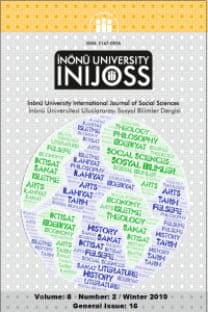DUAL NATURE OF VIOLENCE AND DIVIDED SELF OF MAN IN THE POEMS OF TED HUGHES
Öz
Considering the period in which he lived,
known as the ‘Violent 70s’, it is not surprising that Ted Hughes deals with the
theme of violence in his poems. Unlike Hughes’ contemporaries, man and animal
dichotomy in his ecologically conscious poems does not serve to set man apart
from the rest of the creation, or to show his distinguishing features, but to
criticizes the modern man that lost his bonds with nature and his own self.
What he conveys through animal imagery is that once man had strong bonds with
nature, just like animals, yet technology and urbanisation pull him away from
his own nature. His distinctive ecopoems associates nature with violence in an
unconventional manner. Unlike the conventional depictions of violence as merely
a destructive deadly physical force, Hughes depicts it as the primal and
indispensible energy of nature. ‘Hughesian’ violence essentially is an
expression of energy that splits up with moral implications of mankind. While the Nature’s violence is
represented as a life-giver, vital and powerful energy in a positive way,
modern man in his early poems is the representative of negative violence. This
paper argues that Hughes’ animal poems can be classified under the recently
emerged
subgenre, ecopoetry. Ecopoetry
addresses contemporary problems and issues in ways that are ecocentric and
respects the integrity of the other-than-human world, challenging the belief
that humans are meant to have dominion over nature (Gray and Wirth, 2013). In
this regard, Hughes’ poems remind man of his capacity and real place in nature
through the animals and criticize the so-called civilised man challenging his
superiority through depicting him weak and pacified in nature, due to his
disengagement with his own nature. His poetry gives the message that once man
stops ignoring his bonds with Nature and uses Culture to strengthen this bond,
he will reunite his divided self and live harmoniously within the ecological
system.
Anahtar Kelimeler:
Ted Hughes, ecopoetry, ecocriticism, violence, culture, nature, man, duality
___
1. Baby, K. (2010). “Violence in the poetry of Ted Hughes : an organic growth.”2. Retrieved February 12, 2015, from http://shodhganga.inflibnet.ac.in/handle/10603/243
3. Barton, A. (2004). “Anthropomorphism malign or benign.”
4. Retrieved January 26, 2015, from <<http://www.lancaster.ac.uk/users/philosophy/awaymave/onlineresources/diss05/alibarton.doc>>
5. Bryson, J. (2002). Ecopoetry: A critical introduction (p. Xxvii). Salt Lake City: University of Utah Press.
6. Edmons, S. (2014). “The formation of Ted Hughes's vision of animals” (G. Groszewski, Ed.). The Ted Hughes
7. Society Journal, 4(1), 70-84. Retrieved February 2, 2015, from http://www.thetedhughessociety.org/documents/The Ted Hughes Society Journal Vol. 4 07 July 2014.pdf
8. Gifford, T. (2011). The Cambridge Companion to Ted Hughes (pp. 27-30). Cambridge: Cambridge University Press.
9. Guha, S. (2014). “The question of violence and vitality in the poetry of Ted Hughes.” An International Kournal of Humanities and Social Sciences, 1(3), 474-490. Retrieved February 21, 2015, from http://files.hostgator.co.in/hostgator201172/file/2014010304.pdf
10. Hughes, T., & Scammell, W. (1995). “Poetry and violence.” In Winter pollen: Occasional prose. New York: Picador USA.
11. Hughes, T. (1960). Lupercal. London: Faber and Faber.
12. Hughes, T. (1957). The Hawk in the Rain. New York: Harper.
13. Ingelbien, R. (2002). Misreading England: Poetry and nationhood since the Second World War. Amsterdam: Rodopi Bv Editions.
14. Johnson, O. (1991). “Ted Hughes : Speaking for the earth.”
15. Retrieved January 30, 2015, from http://etheses.dur.ac.uk/1483/
16. Lidstorm, S., & Garrard, G. (2014). “Images Adequate to Our Predicament: Ecology, Environment and Ecopoetics.” Environmental Humanities, (p.35-53).
17. Maling, C. (2013, November 30). Planting Roots: A Survey of Introductions to Ecopoetry and Ecocriticism.
18. Retrieved from http://cordite.org.au/essays/planting-roots/
19. Monjian, Mercedes Cunningham. Robinson Jeffers, a Study in Inhumanism. Pittsburgh: U of Pittsburgh, 1958. Print.
20. Nietzsche, F., & Wayne, T. (2004). Ecce homo how one becomes what one is; & the Antichrist : A curse on Christianity. New York: Algora Pub.
21. Reagan, D. (1973). Ted Hughes: Hairtusk the crow-man and his earth animals (p. 47). Texas.
22. Rites, L. (1977). Wolf Masks. London: Kennikat Press.
23. Wirth, A., & Gray, L. (Eds.). (2013). The Ecopoetry Anthology. San Antonio, Texas: Trinity University Press.
24. Wormald, M., Roberts, N., & Gifford, T. (2013). Ted Hughes: From Cambridge to Collected (p. 10). New York: Palgrave Macmillan.
- ISSN: 2147-0936
- Yayın Aralığı: Yılda 2 Sayı
- Yayıncı: İnönü Üniversitesi
Sayıdaki Diğer Makaleler
A KOHUTIAN APPROACH TO “A BIT OF SINGING AND DANCING” BY SUSAN HILL
EDMUND BURKE: “REFLECTIONS ON THE REVOLUTION IN FRANCE”1
DUAL NATURE OF VIOLENCE AND DIVIDED SELF OF MAN IN THE POEMS OF TED HUGHES
CLOUD NINE IN RELATION TO EPIC THEATRE
CLASS AND SOCIAL IDENTITY IN WILL SELF’S BETWEEN THE CONCEITS
QUEERING THE SPHERE IN BROKEBACK MOUNTAIN: HOMOSEXUAL BODY IN NATURE
JAMES JOYCE ON ART, POETICS AND PORNOGRAPHY
DISEMPOWERED ‘OTHERS’ AND THE FEMALE SOLIDARITY IN SUE TOWNSEND’S BAZAAR AND RUMMAGE (1982)
